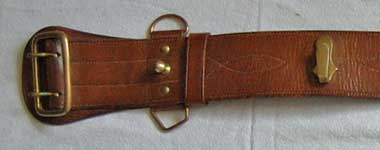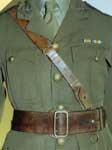Sam Browne Equipment: Component Pictures and Data (Sealed Patterns)
Belts, Waist
Belt, waist, brown, sword, “Sam Browne.” (Mark I.)
Belt, waist, brown, sword, “Sam Browne” (Mark II.)
Belt, waist, sword, Sam Browne, Mark II.
Belt, waist, sword, “Sam Browne”
Stores Ref. A1/AA 0230 Belt, waist, sword, Sam Browne, Mark II.
Stores Ref. CN/AA 0230 Belt, waist, sword, Sam Browne, Mark II.
 Notified by LoC 10440, approved 28th December, 1900, this was 2 3/8-in. wide, with its upper edge fitted with four brass dees, two at the back and one each side for the attachment of the Belts, shoulder, sword. The inside of the belt was lined with faced basil. Two brass rings were fitted on the lower left edge, for the straps of the Frog, belt, waist. These were set slightly closer, putting the lower loops on a diagonal line with the brace dees, in continuation of the Frog strap alignments. Positioned centrally, above the sword frog rings was a brass hook, rivetted to the Belt. The Belt had a double-tongued, Double buckle, of bridge-barred form and with distinctive profile. Stitched behind the Belt, to prevent the buckle marking the tunic, there was a Safe, which was wider than the Belt. On the diagonal line, between the left front upper dee and lower sword ring, was a large mushroom headed stud. The running end of the Belt was secured to this stud, having first passed through a leather runner. The dees and loops, on the left side, were held by chapes, sandwiched between the Belt and its basil lining. Unaccountably, the right side dees are held by visible chapes, that straddle the Belt edge. All chapes were stitched in place and further secured by a single brass rivet. Logistical problems prevent KW presenting the required photos. Shown left is a 2WW Belt, with only 4 dees and quadrilateral sword dees. From the Rog Dennis Collection, photograph © Rog Dennis 2010. Below right is a correct Sam Browne belt,
Notified by LoC 10440, approved 28th December, 1900, this was 2 3/8-in. wide, with its upper edge fitted with four brass dees, two at the back and one each side for the attachment of the Belts, shoulder, sword. The inside of the belt was lined with faced basil. Two brass rings were fitted on the lower left edge, for the straps of the Frog, belt, waist. These were set slightly closer, putting the lower loops on a diagonal line with the brace dees, in continuation of the Frog strap alignments. Positioned centrally, above the sword frog rings was a brass hook, rivetted to the Belt. The Belt had a double-tongued, Double buckle, of bridge-barred form and with distinctive profile. Stitched behind the Belt, to prevent the buckle marking the tunic, there was a Safe, which was wider than the Belt. On the diagonal line, between the left front upper dee and lower sword ring, was a large mushroom headed stud. The running end of the Belt was secured to this stud, having first passed through a leather runner. The dees and loops, on the left side, were held by chapes, sandwiched between the Belt and its basil lining. Unaccountably, the right side dees are held by visible chapes, that straddle the Belt edge. All chapes were stitched in place and further secured by a single brass rivet. Logistical problems prevent KW presenting the required photos. Shown left is a 2WW Belt, with only 4 dees and quadrilateral sword dees. From the Rog Dennis Collection, photograph © Rog Dennis 2010. Below right is a correct Sam Browne belt,
 LoC 11267, with approval dates of 12th March and 16th July, 1902, changed each component to Mark II, items being made from “…lighter material throughout…”. Bridle leather was not made to a fixed thickness, so thinner bridle leather is feasible. In the case of the Waist belt it was simply stated as being “…narrower…”. In fact it changed from 2 3/8 to 2 1/8-inches. The word “brown” was dropped quietly from both Marks, between 1910 and 1915 – undocumented. Five days from the Armistice, LoC 21689 was authorised on 6th November, the Army suddenly deciding to separate the Frog from the Waist belt. The quotation marks were dropped from Sam Browne and the Mark II had its brackets dropped, so becoming Belt, waist, sword, Sam Browne, Mark II.
LoC 11267, with approval dates of 12th March and 16th July, 1902, changed each component to Mark II, items being made from “…lighter material throughout…”. Bridle leather was not made to a fixed thickness, so thinner bridle leather is feasible. In the case of the Waist belt it was simply stated as being “…narrower…”. In fact it changed from 2 3/8 to 2 1/8-inches. The word “brown” was dropped quietly from both Marks, between 1910 and 1915 – undocumented. Five days from the Armistice, LoC 21689 was authorised on 6th November, the Army suddenly deciding to separate the Frog from the Waist belt. The quotation marks were dropped from Sam Browne and the Mark II had its brackets dropped, so becoming Belt, waist, sword, Sam Browne, Mark II.
In 1924, LoC A 3 removed the Mark II designation from the nomenclature. The quotation marks having been removed by LoC 21689 in 1918, they now suddenly reappeared, both in the Old and New Designations!
LoC C 4686 comprised a full listing of what had been V.A.O.S. Section A1, which was now transferred to C.C.N. (Catalogue of Clothing & Necessaries), Section CN. No change of nomenclature was involved, just the stores code prefixes changing, on the remaining three items of the Sam Browne.
Belt, waist, brown, sword – Variants
Prior to being regularized by the Army Order, Belts have been noted that must be at least 3-nches wide, possibly more. The complement of 6 brass loops, variously of circular and “D” form, could be increased to 8, by corresponding loops being placed under the right hand belt loops, for Water-bottle carriers to be attached. The number of dees also decreased to just two left upper ones, allowing only a single diagonal brace. Some variants had no loops at all, being perhaps worn by female officers. The rounded corners and bellied short sides of rectangular belt buckle sometimes changed to a sharp-cornered, straight sided rectangle, often as a regimental variation. A few buckles were completely oval and “Bobs” Roberts V.C., later C.-in-C. of the British Army had a single oval buckle. Both of these still had double tongues. The upper edge dees can be low-arch, or high-arch in shape, sometimes even being rings. When the Frog straps were made narrower, the sword rings changed to a quadrilateral, some even of trapezoidal form and all mounted with various alignments. Rivets can vary, from the floral pattern of Sam’s own belt to dome-headed versions of varying heights and profiles. Similar variations can be found in the studs. In fact, as far as any permutation can be considered, you name it – it will probably exist!
© R.J. Dennis July 2010